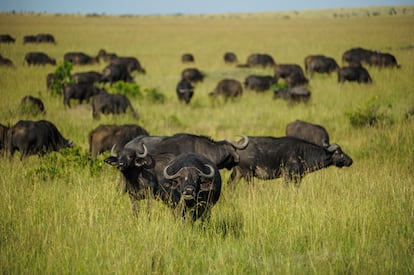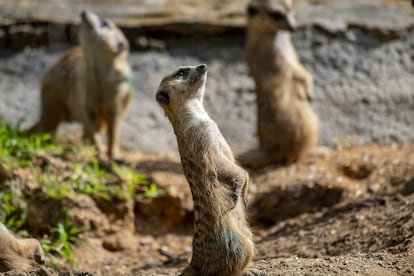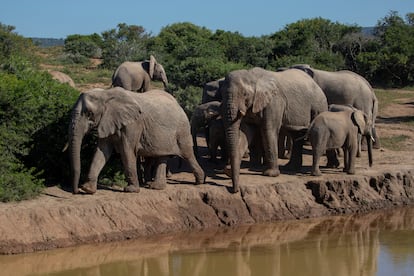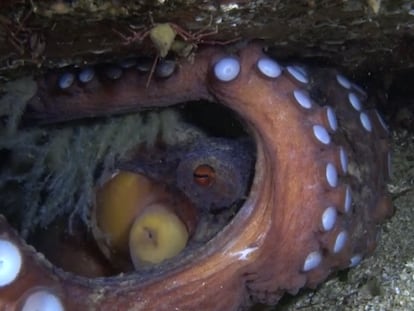This how animals make collective decisions: Bees dance and the elephant matriarchs decide
Species that live in social groups have different ways of communicating preferences

Social life has its benefits. Animals that live in groups are better protected from predators, allowing them more time to feed and care for their offspring. But each individual within the group has different needs. For example, some may need more time to digest, while others may want to move to a new area with food or water.
To keep the group together, most social species need to make collective decisions, which is why they each have their own voting systems. Sometimes, the opinions of all individuals count equally, while for other species, only part of the group can vote. In still others, the leader holds all the power. Below are five cases in point.
Buffalo: females decide where to graze
Tanzania’s Lake Manyara National Park offers several places for buffalo to graze. In the afternoon, the herd is often found resting on the lake shore. Most lie down, but now and then a buffalo will stand up, shake a little as if to stretch its legs, and lie down again. When the sun touches the horizon, it’s time to look for a place with good grass to eat. The herd rises and starts walking in the same direction. Somehow, they all know where to go.
In the 1990s, Herbert Prins, a professor of ecology at Wageningen University in the Netherlands, noticed that when females stood up to stretch their legs, they were actually voting. After shaking and before lying down, they “looked” in one direction for a minute, holding their heads higher than when resting but lower than when alert. Once the females had expressed their preferences, the herd would move in the direction with the most votes.
Bees: scouts choose the new nest site
When a hive grows too large, the queen and half the colony leave to find a new home, while a young queen continues to rule the old nest. Selecting a new nest begins with the departure of hundreds of scout bees that go from tree to tree to inspect each cavity for the right place. They consider factors such as size, light, humidity, and temperature.
When the search ends, the scouts return to the hive and voting begins. In a kind of dance, each bee communicates the site that it likes the most, providing information about its location and its quality. The decision is made when many bees agree through their dances. A minute later, the bees are on their way to their new home.
Swans: ritual before flying

Migratory birds must make many important decisions during their journeys, including when to resume flight after feeding and resting. Waiting too long can extend the journey and prevent them from reaching their destination on time. But not eating enough and leaving too early can cause them to run out of energy while flying. In social birds, these decisions have to be made by a consensus of hundreds of individuals.
Some species, like swans, vote democratically through ritualized behavior, i.e., the successive repetition of a stereotyped behavior. When an individual is ready to take off, it begins to shake its head and flap its wings restlessly. Gradually, more individuals join the ritual, until the entire flock suddenly intensifies its movements 30 seconds before takeoff. It’s time to leave.
Meerkats: voting calls

Meerkats are found in Africa and live in close-knit groups of up to 50 individuals. They are mainly carnivores, foraging in the sand for small prey. This means that they cannot communicate with each other visually while foraging. As a result, they have developed a wide range of vocalizations that they use in a variety of contexts. For example, to avoid moving too far away from each other, they use the “proximity” vocalization.
Meerkats use the “let’s move” vocalization when they sense that there is no prey nearby, and it’s safe to go to another feeding area. When two other meerkats repeat the vocalization, that’s enough to make the entire group move, according to a study published in 2010. This was true regardless of the dominance, sex, or age of the individuals making the call. Anyone can judge the availability of food.
Elephants: the matriarch decides

There is no democratic voting among elephants. The final decision about when and where to eat is made by a single individual — the matriarch — the oldest female in the group. Everyone accepts her leadership because experience and wisdom often go hand in hand. Indeed, several studies have shown that older elephants make better choices.
For example, elephants will often encounter lions in the savanna, but lions are not always a threat. A small group of lionesses is no match for a herd of elephants protecting their young. However, male lions are much more dangerous, and there is more risk when a group of lionesses is very large. One study showed that the older the matriarch, the better she can assess risk from predators. With elephants, wisdom reigns.
Sign up for our weekly newsletter to get more English-language news coverage from EL PAÍS USA Edition
Tu suscripción se está usando en otro dispositivo
¿Quieres añadir otro usuario a tu suscripción?
Si continúas leyendo en este dispositivo, no se podrá leer en el otro.
FlechaTu suscripción se está usando en otro dispositivo y solo puedes acceder a EL PAÍS desde un dispositivo a la vez.
Si quieres compartir tu cuenta, cambia tu suscripción a la modalidad Premium, así podrás añadir otro usuario. Cada uno accederá con su propia cuenta de email, lo que os permitirá personalizar vuestra experiencia en EL PAÍS.
¿Tienes una suscripción de empresa? Accede aquí para contratar más cuentas.
En el caso de no saber quién está usando tu cuenta, te recomendamos cambiar tu contraseña aquí.
Si decides continuar compartiendo tu cuenta, este mensaje se mostrará en tu dispositivo y en el de la otra persona que está usando tu cuenta de forma indefinida, afectando a tu experiencia de lectura. Puedes consultar aquí los términos y condiciones de la suscripción digital.











































